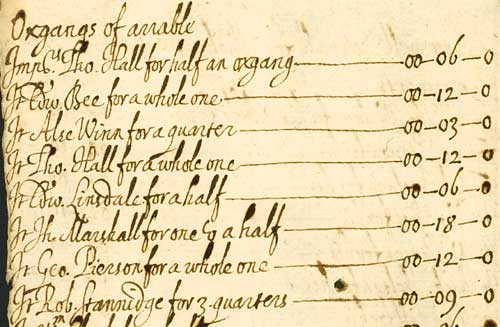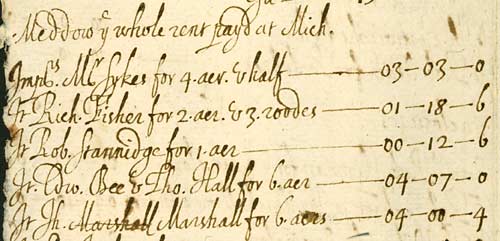Measurements
The standard linear measure in the Imperial system was the mile, which was divided into furlongs, chains, yards, feet and inches.
The mile was based on a Roman measurement of 1,000 paces. The word 'furlong' comes from 'a furrow long', or the distance that could be ploughed by an ox without a rest. A foot was traditionally the length of a man's foot, and 'inch' comes from the Latin word 'uncia', meaning 'one-twelfth'.
This system is still used by many people in the UK to measure distance (miles), and their own height (feet and inches).
Table of units of standard linear measurement:
| Measure |
Equivalent |
| 3 barleycorns |
1 inch (in or ") |
| 12 inches |
1 foot (ft or ') |
| 3 feet |
1 yard (yd) |
| 5½ yards |
1 perch, pole or rod |
| 40 poles |
1 furlong |
| 8 furlongs |
1 mile |
| 3 miles |
1 league |
Therefore, there were 5280 feet, and 1760 yards in 1 English mile.
Many maps use land surveyors' measures of distance in their scales. These are as follows:
| Measure |
Equivalent |
| 100 links (4 poles, 22 yards or 66 feet) |
1 chain |
| 10 chains |
1 furlong |
| 80 chains |
1 mile |

Detail of a scale of chains from plan of Newark Fields, pre-1768 (Ne 6 P 3/15/3)
Metric units of measurements are as follows:
| Measure |
Equivalent |
| 10 millimetres (mm) |
1 centimetre (cm) |
| 100 centimetres (cm) |
1 metre (m) |
| 1000 metres (m) |
1 kilometre (km) |
Kilometres are shorter than miles: 1 foot equals 30.5 centimetres, and 1 mile equals 1.6 kilometres. Conversion tables are widely available in printed books and on the internet.
Area
There were a wide variety of traditional measurements of land used into the seventeenth century. The following measurements were based on how much could be produced or worked from a particular piece of land, and therefore varied widely according to the quality of the soil and the climate. They do not have absolute quantities, but can be measured against each other:
| Measure |
Equivalent |
| 1 acre |
The area that could be ploughed by a team of eight oxen in one day |
| 1 hide |
The area deemed to be able to support a typical peasant family, ploughed in a year by a team of eight oxen. Nominally 120 acres, although the actual area varied. Also called (among other names) a carucate or a ploughland
A hide was made up of 8 oxgangs or bovates, or 4 virgates |
In this 1642 rental from the parish of Cromwell, meadow ground is given in acres, but arable land (which had to be ploughed) in oxgangs.

Detail from Cromwell rental, 1642 (Ne A 54) - 'Oxgangs of arrable'
The standard area measure in the Imperial system was the acre, which was divided into roods and perches. Area measurements were often abbreviated using the letters a.r.p.
The acre was defined officially as being 1 furlong (40 poles = 660 feet) in length, and 4 poles (66 feet) in breadth. The rectangular shape of this measure came about because arable fields were made up of long strips of land, each containing furrows running lengthwise. One 'furrow long' = 1 furlong.
However, most land was not this shape, so square measurements became standardised, in order to be able to measure irregularly shaped pieces of land. Table of units of square measurement:
| Measure |
Equivalent |
| 144 square inches |
1 square foot |
| 9 square feet |
1 square yard |
| 30¼ square yards |
1 perch |
| 40 perches |
1 rood |
| 4 roods |
1 acre |
| 640 acres |
1 square mile |
Here is another detail from the 1642 rental from the parish of Cromwell, showing rents for meadow land, measured in acres ('acr') and roods ('roodes').

Detail from Cromwell rental, 1642 (Ne A 54) - 'Meddow the whole rent'
Metric measurements are as follows:
| Measure |
Equivalent |
| 100 square millimetres (sq. mm) |
1 square centimetre (sq. cm) |
| 10,000 square centimetres (sq. cm) |
1 square metre (sq. m) |
| 100 square metres |
1 are |
| 100 ares (10,000 square metres) |
1 hectare |
| 100 hectares (1,000,000 square metres) |
1 square kilometre |
Hectares are larger than acres: 1 acre equals 0.4 hectares. Conversion tables are widely available in printed books and on the internet.
Next page: Volumes or Capacity